Opus Sectile
Artist: Unknown
Date: V century A.D.
Classification: Mosaic
Materials: Marble, Stone
Total Cost: € 30,000
Description
In the upper part of the wall, at the corner with the apse arch of the chapel of Saints Cipriano and Giustina, in the ancient entrance of the Lateran Baptistery, there is a decoration in opus sectile. This Latin term indicates an art technique where stone materials were cut and inlaid into walls and floors to make a picture or pattern. The Lateran opus sectile was made using very hard marble, difficult to process and cut; also very expensive, such as red porphyry, coming from Egypt and used above all by the emperors (just think of the sarcophagus of Costanza or Sant'Elena, both related to Emperor Constantino) and the green porphyry, commonly called serpentino, from Greece. The decoration can be dated around the last quarter of the fifth century, therefore shortly after the mosaics in the apse of the chapel, conventionally dated during the pontificate of Pope Ilario (461-468). These are among the oldest stones and mosaics in Christian history. A very interesting aspect is that few examples of wall opus sectile have been preserved. Among the best-known examples of wall decoration of this type is the Domus of Porta Marina in Ostia, now in the Museo Nazionale dell’Alto Medioevo in Rome, or the panels from the Domus of Giunio Basso, currently in Museo Nazionale Romano in Rome. Both Domus decorations can be dated to the 4th century. Important is the Neonian baptistery in Ravenna, where the opus sectile coexists with the mosaic decoration.
Restoration Procedures
-
Consolidation of mortar substrates - 25 kg of Ledan TA1 mortar was injected
-
Securing numerous stone elements that were no longer attached to the stucco
-
Removal of the cement grout in the areas missing the stone material
-
Cleaning of the stone surface to remove oxidized vegetable oils applied in the past
-
Graphic documentation and photography of the whole work
-
Removal of all of the internal cement on the panel with metal frames
-
The completion of the grouting work in the missing stone element parts
-
Removal from the wall of all the stone portions mounted in the metal frame
-
Removal of the iron frame and the cement mortars from the back and the stone elements
-
Once free from the cement, the stone elements will be on new support
-
Relocation of the panel in situ
-
Uniform cleaning of the whole work and an application of a final protective coat
Detail
Patrons:
Billy Dingman
Artist: Unknown
Date: V century A.D.
Provenience: chapel of Saints Cipriano and Giustina, in the ancient entrance of the Lateran Baptistery
Materials: Marble, Stone
Department:
Christian AntiquitiesCurators:
Dr. Umberto UtroArchaeological Areas:
Excavations of St. John LateranLaboratories:
MosaicTotal Cost
€ 30,000
Final Restoration Report - Opus Sectile
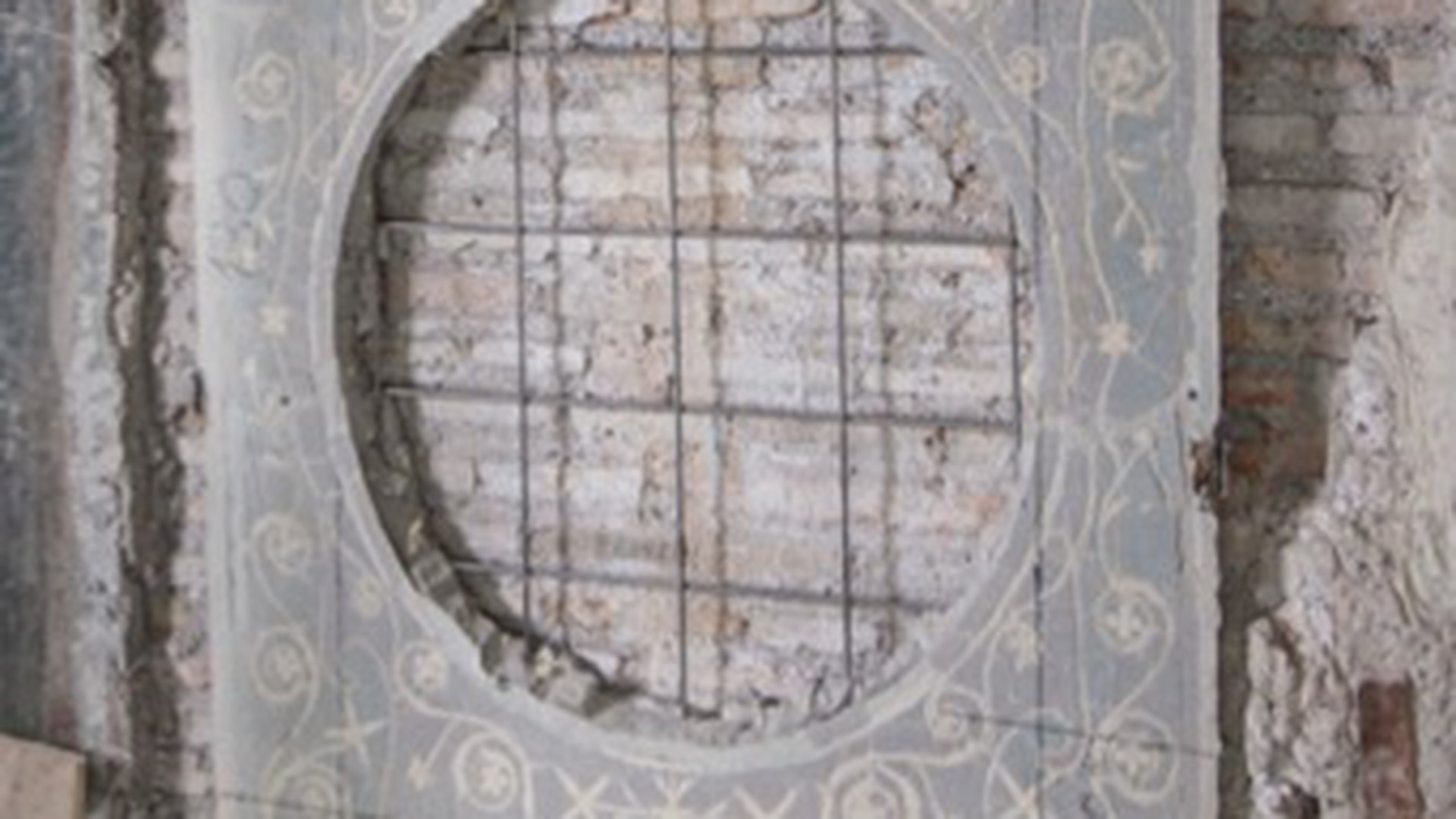
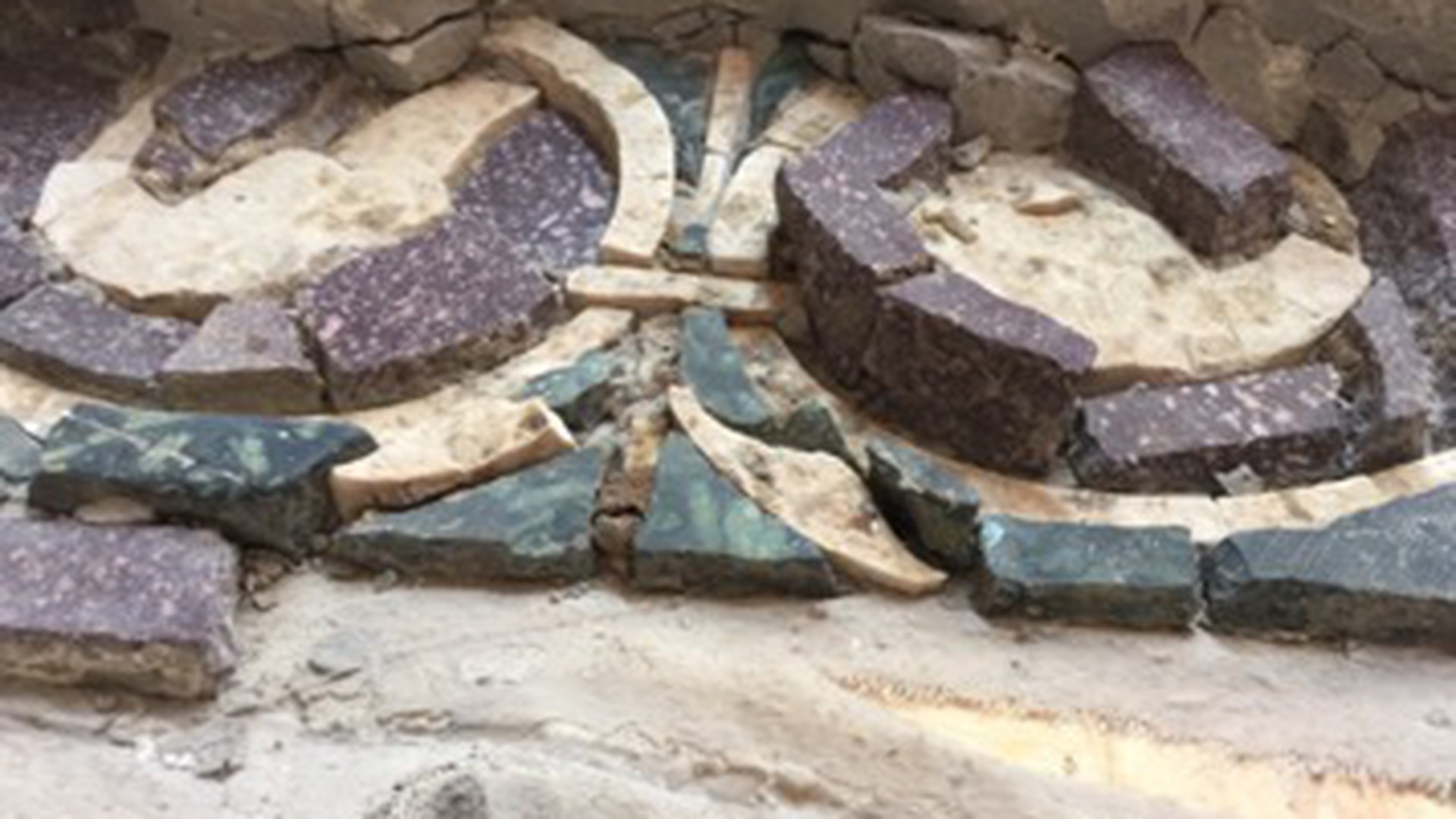
The opus sectile was in a compromised state of preservation from a conservative and aesthetic point of view. Large squares divide the stone decorations with plant ornamentation and squares with candelabra and birds on racemes. The lithotypes used are yellow of Numidia Egyptian, red porphyry, green porphyry from Greece called serpentine, white limestone called "palombino" and pavonazzetto of Turkish origin. The restoration of the opus sectile took place in several stages. The craftsman composed the decorative stone pattern on a resinous mortar called misturine composed of Greek pitch, wax, etc. Restorers worked on the backs of the fragments of terracotta to increase the adhesion between the mortars. Subsequently, restorers bedded the stone decoration to the wall with a mortar-based lime. At a first examination, they noticed that the work already had several past restorations, one from the medieval period and the other from the 20th century. Restorers faced a large portion of detached decoration, reassembled them on cement to create a panel with a metal box, and then repositioned them on-site. Over time it created stresses and detachments to the portions of the sectile. First, restorers consolidated the bedding layers. They used a consolidating agent to allow the lime-based mortars to reattach to the bedding layers between the brick part of the wall and the terracotta part. This operation included injecting the consolidating agent between the detachments and the relative voids. They decided not to fill all the holes to protect the structure's weight. This process helped carry out some nailing, which allowed a re-adhesion of the layers. As for the reattachment of the stone portions, restorers consolidated with injections no longer based on lime but with a synthetic resin dissolved in ethyl alcohol. The misturin is water-repellent by its very nature. Once restorers completed the consolidation phase, they removed the cement filling mortar, especially in the upper part of the sectile between the panel and the arch of the apsidal basin of the old restoration. Precisely during the removal of the cement, some surprises emerged. On the border area between the wall and the arch, fragments of the mosaic decoration of the first decorative arch structure materialized. Also, the end of the sectile candelabrum decoration appeared in the lower right part. This process allowed restorers to establish that the entire arch of the chapel was once part of the mosaic decoration. Restorers also proceeded with bonding portions of stone now detached from the misturin through synthetic consolidant use with a higher percentage.
Once restorers completed the consolidation phase, they cleaned the work, tested various methodologies with the help of the scientific research laboratory, and used compresses with Japanese paper and ammonium bicarbonate. This process allowed the removal of a substance as a protective and enlivening agent in previous restorations of plant-oil protein origin. In addition to substance removal, they removed the old waxes and plasters that covered the sectile. At this point, they tackled the restoration of the sectile portion raised on cement. In agreement with the direction of the works, they decided to remove the panel and lighten it from the cement mortar due to several main factors. The excessive weight compromised the stability of the underlying sectile and the insertion of stone elements that were pertinent but in the wrong position. Thanks to a photo acquisition from the Giovenale archives, it shows the exact position and the state of affairs before the detachment occurred. Restorers polished the entire panel and surrounding areas, which allowed for a wall disassembly. The stone material of the panel and the sectile surrounding it was made safe by veiling with a cotton cloth and starch glue. When the glue dried, the panel was light in the portion of the missing central disk reintegrated in cement. The removal has less weight during the disassembly phase and when positioned on the ground. Once placed on the ground with the cement in sight, they started to remove the metal frame containing the back of the panel and then the cement until all the stone elements were free.
Then restorers applied a new light mortar to a self-supporting panel of fiberglass and aluminum (aereolam) with a total weight of about 150 kg compared to the initial one of about 700 kg. Replacing the panel in the exact position, thanks to the photo, helped adjust the weight on the wall structure, and it's no longer on the decoration in sectile below through steel anchors. Once they completed all these operations, they removed the old grout in the cement mortar and plaster. In agreement with the direction of the works, restorers decided to reintegrate all the reconstructible portions to interrupt the decoration where possible. Where the gaps are extensive, restorers decided to leave in sight the preparation: misturine, elements in terra cotta (tuboli), and mortar. The plastering was done in pozzolan and lime for the deep layers and then in lime and marble powder. They smoothed with lime and calcium carbonate to make the surface more similar to marble. Some fillings have engravings to ensure that the three-dimensionality is similar to the portions of the sectile. There are also pictorial integrations in watercolor. In the large gaps in the panel and surrounding areas, restorers chose a neutral mortar that is not too smooth with an appropriate color. The entire sectile has the protection of a synthetic wax that does not alter chromatically and has an easy removal with alcohol.

Opus Sectile
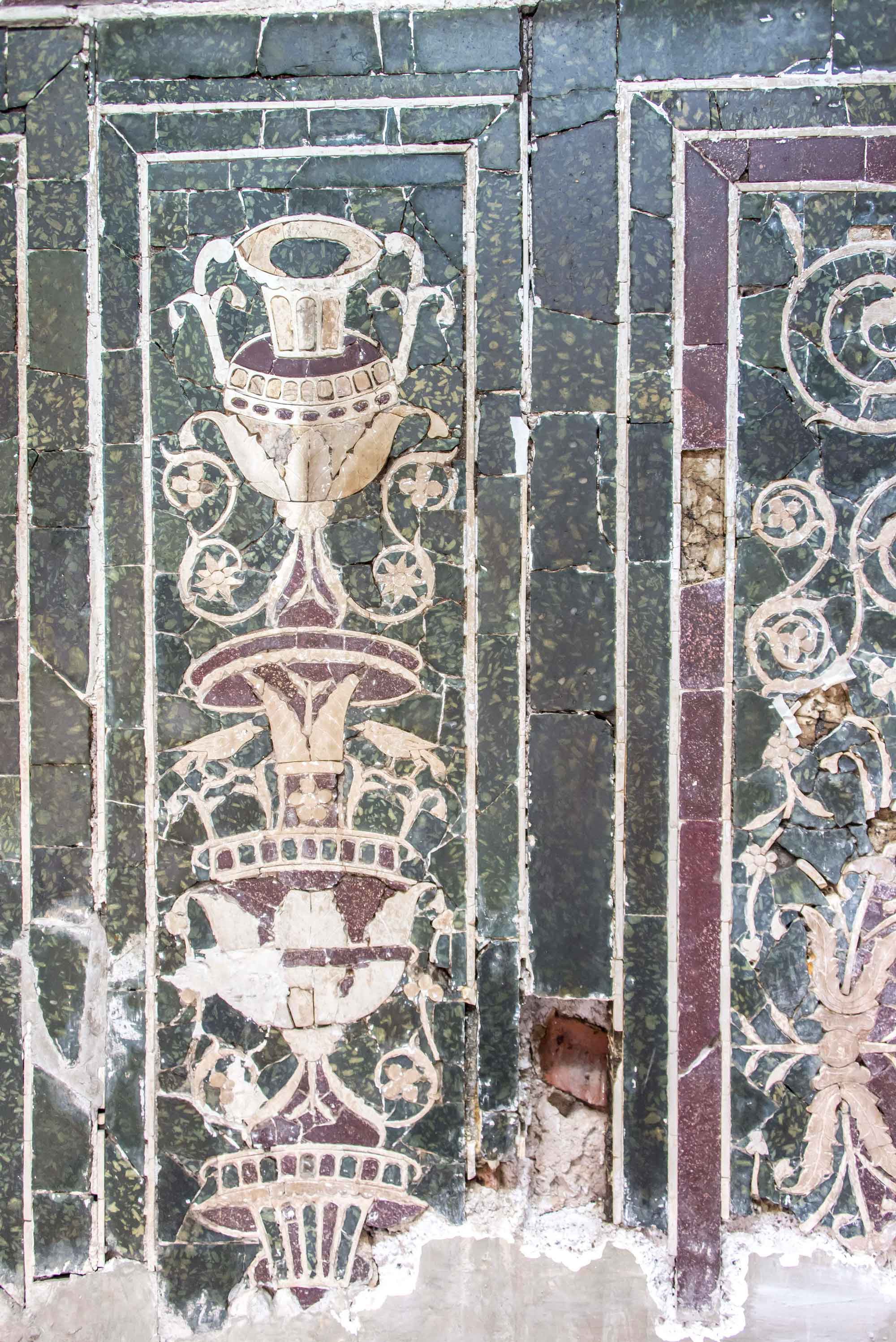
Details
Patrons: Billy Dingman
Artist: Unknown
Date: V century A.D.
Provenience: chapel of Saints Cipriano and Giustina, in the ancient entrance of the Lateran Baptistery
Classification: Mosaic
Materials: Marble, Stone
Archaeological area: Excavations of St. John Lateran
Department: Christian Antiquities
Laboratory: Mosaic
Description
In the upper part of the wall, at the corner with the apse arch of the chapel of Saints Cipriano and Giustina, in the ancient entrance of the Lateran Baptistery, there is a decoration in opus sectile. This Latin term indicates an art technique where stone materials were cut and inlaid into walls and floors to make a picture or pattern. The Lateran opus sectile was made using very hard marble, difficult to process and cut; also very expensive, such as red porphyry, coming from Egypt and used above all by the emperors (just think of the sarcophagus of Costanza or Sant'Elena, both related to Emperor Constantino) and the green porphyry, commonly called serpentino, from Greece. The decoration can be dated around the last quarter of the fifth century, therefore shortly after the mosaics in the apse of the chapel, conventionally dated during the pontificate of Pope Ilario (461-468). These are among the oldest stones and mosaics in Christian history. A very interesting aspect is that few examples of wall opus sectile have been preserved. Among the best-known examples of wall decoration of this type is the Domus of Porta Marina in Ostia, now in the Museo Nazionale dell’Alto Medioevo in Rome, or the panels from the Domus of Giunio Basso, currently in Museo Nazionale Romano in Rome. Both Domus decorations can be dated to the 4th century. Important is the Neonian baptistery in Ravenna, where the opus sectile coexists with the mosaic decoration.
Restoration Procedures
-
Consolidation of mortar substrates - 25 kg of Ledan TA1 mortar was injected
-
Securing numerous stone elements that were no longer attached to the stucco
-
Removal of the cement grout in the areas missing the stone material
-
Cleaning of the stone surface to remove oxidized vegetable oils applied in the past
-
Graphic documentation and photography of the whole work
-
Removal of all of the internal cement on the panel with metal frames
-
The completion of the grouting work in the missing stone element parts
-
Removal from the wall of all the stone portions mounted in the metal frame
-
Removal of the iron frame and the cement mortars from the back and the stone elements
-
Once free from the cement, the stone elements will be on new support
-
Relocation of the panel in situ
-
Uniform cleaning of the whole work and an application of a final protective coat
Restorations Update: Final Restoration Report - Opus Sectile
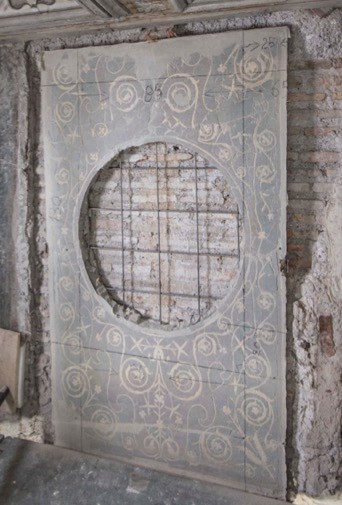
The opus sectile was in a compromised state of preservation from a conservative and aesthetic point of view. Large squares divide the stone decorations with plant ornamentation and squares with candelabra and birds on racemes. The lithotypes used are yellow of Numidia Egyptian, red porphyry, green porphyry from Greece called serpentine, white limestone called "palombino" and pavonazzetto of Turkish origin. The restoration of the opus sectile took place in several stages. The craftsman composed the decorative stone pattern on a resinous mortar called misturine composed of Greek pitch, wax, etc. Restorers worked on the backs of the fragments of terracotta to increase the adhesion between the mortars. Subsequently, restorers bedded the stone decoration to the wall with a mortar-based lime. At a first examination, they noticed that the work already had several past restorations, one from the medieval period and the other from the 20th century. Restorers faced a large portion of detached decoration, reassembled them on cement to create a panel with a metal box, and then repositioned them on-site. Over time it created stresses and detachments to the portions of the sectile. First, restorers consolidated the bedding layers. They used a consolidating agent to allow the lime-based mortars to reattach to the bedding layers between the brick part of the wall and the terracotta part. This operation included injecting the consolidating agent between the detachments and the relative voids. They decided not to fill all the holes to protect the structure's weight. This process helped carry out some nailing, which allowed a re-adhesion of the layers. As for the reattachment of the stone portions, restorers consolidated with injections no longer based on lime but with a synthetic resin dissolved in ethyl alcohol. The misturin is water-repellent by its very nature. Once restorers completed the consolidation phase, they removed the cement filling mortar, especially in the upper part of the sectile between the panel and the arch of the apsidal basin of the old restoration. Precisely during the removal of the cement, some surprises emerged. On the border area between the wall and the arch, fragments of the mosaic decoration of the first decorative arch structure materialized. Also, the end of the sectile candelabrum decoration appeared in the lower right part. This process allowed restorers to establish that the entire arch of the chapel was once part of the mosaic decoration. Restorers also proceeded with bonding portions of stone now detached from the misturin through synthetic consolidant use with a higher percentage.
Once restorers completed the consolidation phase, they cleaned the work, tested various methodologies with the help of the scientific research laboratory, and used compresses with Japanese paper and ammonium bicarbonate. This process allowed the removal of a substance as a protective and enlivening agent in previous restorations of plant-oil protein origin. In addition to substance removal, they removed the old waxes and plasters that covered the sectile. At this point, they tackled the restoration of the sectile portion raised on cement. In agreement with the direction of the works, they decided to remove the panel and lighten it from the cement mortar due to several main factors. The excessive weight compromised the stability of the underlying sectile and the insertion of stone elements that were pertinent but in the wrong position. Thanks to a photo acquisition from the Giovenale archives, it shows the exact position and the state of affairs before the detachment occurred. Restorers polished the entire panel and surrounding areas, which allowed for a wall disassembly. The stone material of the panel and the sectile surrounding it was made safe by veiling with a cotton cloth and starch glue. When the glue dried, the panel was light in the portion of the missing central disk reintegrated in cement. The removal has less weight during the disassembly phase and when positioned on the ground. Once placed on the ground with the cement in sight, they started to remove the metal frame containing the back of the panel and then the cement until all the stone elements were free.
Then restorers applied a new light mortar to a self-supporting panel of fiberglass and aluminum (aereolam) with a total weight of about 150 kg compared to the initial one of about 700 kg. Replacing the panel in the exact position, thanks to the photo, helped adjust the weight on the wall structure, and it's no longer on the decoration in sectile below through steel anchors. Once they completed all these operations, they removed the old grout in the cement mortar and plaster. In agreement with the direction of the works, restorers decided to reintegrate all the reconstructible portions to interrupt the decoration where possible. Where the gaps are extensive, restorers decided to leave in sight the preparation: misturine, elements in terra cotta (tuboli), and mortar. The plastering was done in pozzolan and lime for the deep layers and then in lime and marble powder. They smoothed with lime and calcium carbonate to make the surface more similar to marble. Some fillings have engravings to ensure that the three-dimensionality is similar to the portions of the sectile. There are also pictorial integrations in watercolor. In the large gaps in the panel and surrounding areas, restorers chose a neutral mortar that is not too smooth with an appropriate color. The entire sectile has the protection of a synthetic wax that does not alter chromatically and has an easy removal with alcohol.
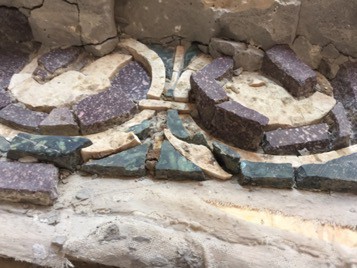

© 2025 Patrons of the Arts
in the Vatican Museums
Vatican Museums V-00120,
Vatican City State (Europe)
+39 0669864499
